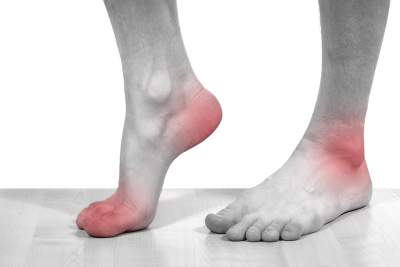 Gout is a disease that affects the joints due to elevated levels them uric acid.
Gout is a disease that affects the joints due to elevated levels them uric acid.
Before the disease struck mainly men of 40-60 years, but the last decade gout often affects women and young people.
Physician and endocrinologist of the medical group of companies ADONIS Natalia Lyashenko called the symptoms, causes of gout and treatment methods.
Doctor Natalia Lyashenko: “gout is a form of arthritis caused by the deposition of urate crystals (uric acid crystals) in the joint, causing inflammation and intense pain during gout attacks. The urate crystals are formed when there is increased level of uric acid in the blood. ”
The human body produces uric acid when it breaks the purines – substances that are in the body. Purines are also found in certain foods, such as steak and seafood. Other foods also increase levels of uric acid, for example alcoholic beverages, especially beer, and drinks sweetened with fruit sugar (fructose).
High level uric acid symptoms
• pain in the big toe
• intense pain and inflammation of the joints
• difficulty with urination
• erratic pulse
• pain in the knees
• kidney stones
• fatigue
• hard formations around the joints
Normally uric acid dissolves in blood and passes through kidneys into the urine. But sometimes the body produces too much acid or the kidneys excrete too little. When this happens, uric acid can build up forming sharp crystals in the joint or surrounding tissues. This causes pain, inflammation and swelling.
Gout – causes
Hypertension ( high blood pressure).
Diabetes.
Renal failure.
Dyslipidemia ( increase in cholesterol and blood triglycerides).
Obesity.
Anemia.
Heredity.
Gender (male).
Taking certain medications ( thiazide diuretics).
Risk factors
Man is more inclined to develop gout if he has high levels of uric acid. Factors that increase the level of uric acid in the body include:
Diet
A food rich in meat and seafood, as well as drinks which contain fruit sugar (fructose). The consumption of alcohol, especially beer, also increases the risk of gout.
Obesity
If you are overweight, your body produces more uric acid, respectively, the buds have a heavy load.
Disease
Some diseases and conditions increase the risk of gout. These include high blood pressure and chronic diseases such as diabetes, metabolic syndrome, heart disease and kidney failure.
Certain drugs
The use of a thiazide diuretic, which is commonly used in the treatment of hypertension, and low-dose aspirin also can increase uric acid levels.
Genetics
If other members of your family had gout, you are more likely to develop this disease.
Age and gender
Gout is more common in men, primarily because women have lower levels of uric acid. After menopause the level of uric acid in women are approaching those of men. In the past gout often develops between the ages of 30 to 50 years.
Recent surgery or injury
Recent surgery or trauma is associated with increased risk of developing gout.
The symptoms of gout
Signs and symptoms of gout almost always occur suddenly, often at night. They include:
1. Intense pain in the joints. Gout usually affects the joints of the big toe, but the disease may occur in any other joint. It may be the ankles, knees, elbows, wrists and fingers. The pain is usually more acute during the first 4-12 hours.
2. Prolonged discomfort. After acute pain, the discomfort decreases. Some joint discomfort may last from several days to several weeks. Later attacks of gout can last longer and more will affect the joints.
3. The inflammation and redness. The affected joint or joints become swollen, warm and red.
4. Limited range of motion. When gout progresses, you may not be able to move the joints.
Diagnosis of the disease
In order to identify the presence of gout should:
1. To determine the level of uric acid in the blood and in the urine daily.
2. To make the analysis of synovial fluid of the joint.
3. An x-ray.
4. If necessary a CT or MRI.
Treatment of gout
Gout treatment normally includes drugs, who picks the doctor and the patient, based on the current state of health.
Drugs to treat acute attacks and prevent future attacks include non-steroidal anti-inflammatory drugs (drugs based on cochicine, corticosteroids).
Doctors may prescribe drugs to prevent the complications of gout – drugs that block the production of uric acid (Allopurinol, febuxostat) and medications that improve the removal of uric acid (probenecid, leisured).
Diet for gout
Medication is the most effective way to treat acute gout and can prevent re-pristup gout. However, you need to change some eating habits and lifestyle.
1. Eliminate or limit consumption of alcoholic beverages and drinks that contain fructose. Instead, drink plenty of soft drinks, particularly water.
2. Limit your intake of meat, fish and poultry in the diet. This is especially true of smoked and cooked sausages, frankfurters, sausages, canned food.
3. Eat more whole grains, fruits, vegetables and fewer refined carbohydrates, such as cream cakes, pastries, candies, products from puff and fancy pastry, white bread.
4. Exercise regularly. Maintaining the body in a healthy weight reduces the risk of gout.
5. Drink plenty of fluids.
6. Eat dairy products low in fat. You can use low-fat yogurt, unsalted cottage cheese, eggs ( not more than one per day).
7. As for grains, then limit yourself to eating only legumes. All because they contain uric acid in large quantity.
8. Do not drink coffee, strong tea, cocoa.
9. Try to use less salt. Doctors advise to stick to a diet №6 (table number 6).
© 2019, paradox. All rights reserved.





